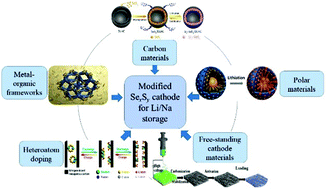Status and prospects of SexSy cathodes for lithium/sodium storage
Abstract
To meet the developing requirements of rechargeable batteries, cathode materials should have light masses, high densities, low costs, low toxicity, small oxidation potentials, and good electronic conductivities. As the cathode active material for lithium storage, sulfur (S) has high theoretical density and cost effectiveness. However, its conductivity is poor. The heavier analogue of S, viz. Se, however, has much larger electronic conductivity and higher density. Combining the advantages of S and Se, a new type of cathode material, namely, SexSy, has attracted much interest in recent years. Though SexSy has good conductivity and high volumetric capacity, the issues of shuttle effects, electrolyte suitability, and volume change during cycling still exist. To alleviate these issues, many groups have made versatile efforts to address SexSy. However, hitherto, there has been no systematic summary of this topic. Convinced by its promising synergetic effect and constructive supplement for S cathodes in rechargeable batteries, we here review the recent progress on SexSy as a cathode material for Li and Na batteries. Their syntheses, structures, electrochemical performances, and the structure–property relationships are referred to. As SexSy is a type of relatively young cathode, the electrolytes for Li–SexSy are also addressed. Finally, the challenges and perspectives for Li/Na–SexSy batteries are given.

- This article is part of the themed collection: 2019 Inorganic Chemistry Frontiers Review-type Articles


 Please wait while we load your content...
Please wait while we load your content...